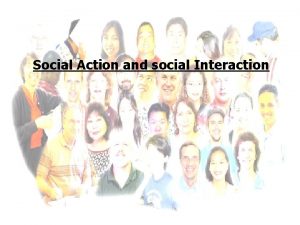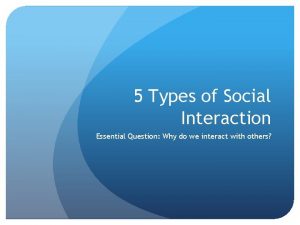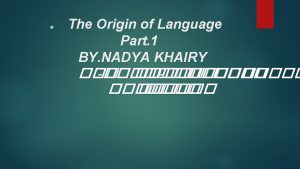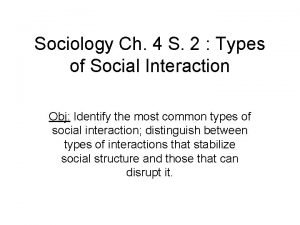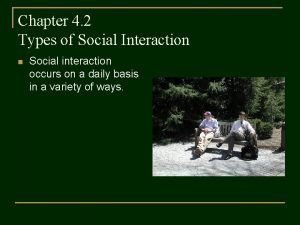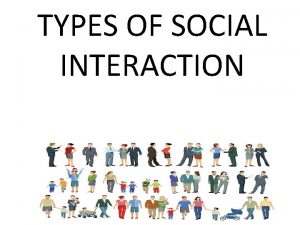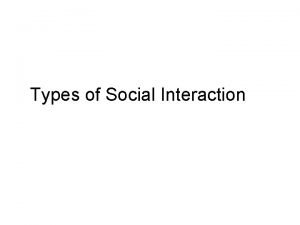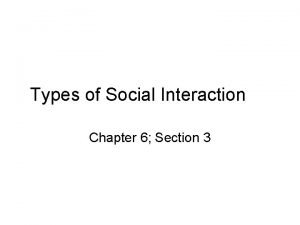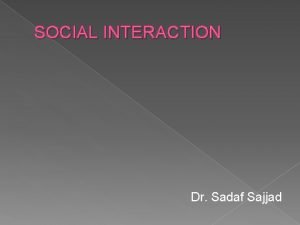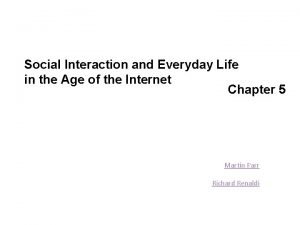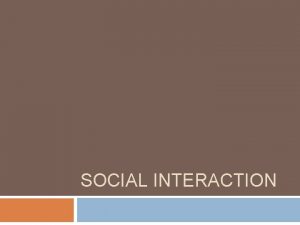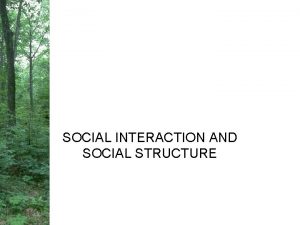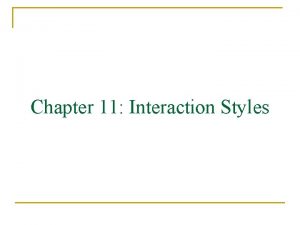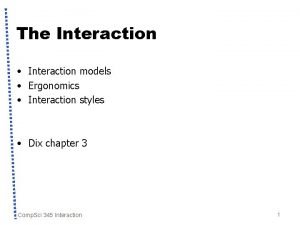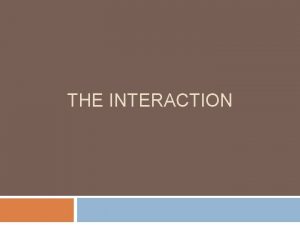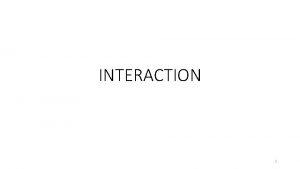Lecture Six Social Interaction the Construction of Social






















- Slides: 22

Lecture Six Social Interaction & the Construction of Social Differences

Social Interaction & Social Structure n Our day to day social interactions are part of the process of socialization and shape our individual identities as well as the social structures in which we live n Social structure can be understood as the way society is organized through patterns of behavior and the ideas that support them

n People create social structure through their actions and the meaning they give to their actions Culture & Ideology Actions/Behavior Social Structure

Ideology & Action = Differences n Ideology is a system of beliefs, values, and ideas that support a social system q n What ought to be, not necessarily what is Ideology (how we think about things) and action (our behavior, what we do) intersect to create a social structure based on differences

Gender, Race, and Sexuality Ideologies/Culture Social Interaction based on those ideas Social Structure of racial, gender, and sexual inequality

Social categories of difference are: Learned through the process of life-long socialization and social interaction 1. q q Indirectly through representations of social life, such as the mass media Directly through interaction with other people such as in our family, work environments, and with friends

“Doing” Difference: Gender, Race, Sexuality Differences are accomplished through our actions and behavior, they are NOT the cause of those actions and behaviors Difference NOT ↓ Behavior/Actions …But ↓ Difference

Mass Media & Differences n As a strong socializing agent the mass media plays a powerful role in shaping our ideas and perceptions of others, especially other groups that we have limited contact with in real life n Watch the video on the next slide and ask yourself: What image of Arabs and Muslims does the media presents us? How do these representations affect our perception of people who are Arab/Muslim?

“Planet of the Arabs”

Constructing the “Arab” in American Culture n In American society, there has been a historic vilification and dehumanization of Arabs and Muslims in the Mass Media n The indirect representation in the mass media of Arabs and Muslims (a group most of us have limited contact with) creates a stereotype that they are: q q Violent Less than human A threat/ Anti-American What else?

Doing “Race” n Stereotyping: exaggerated and inaccurate generalizations about members of a group n Prejudice: negative thoughts and feelings about groups of people and to prejudge people based on group membership n Discrimination: unequal treatment of others based on group membership q q Individual – unequal treatments of others Institutional – inequality in social institutions (education, economy, etc. )

Producing Gender n Gender: social differences assigned to people of different sexes q n Masculinity and femininity are socially defined and vary across time and place Sex: biological differences between people q q Cellular level: chromosomes, sex-specific genes (female: XX; male: XY) Hormonal level: estrogen and testosterone Anatomical: genitals, secondary sex characteristics Reproductive capacity

Sexual Dichotomy n We have a belief in the essential reality of sexual dichotomy (male vs. female). In our culture we have the idea that one’s sex determines one’s gender. In other words we believe that the biology leads to the social, but in fact there is no such connection. q We give meaning to sex differences and make them real through our ideas about gender n We believe that sex & gender are: q Permanent - you are what you are born with q Universal – same meaning across time and space q Exhaustive – every one can be placed in one category q Mutually exclusive – we can’t be in both categories

Constructing Gender & Sex n Cross cultural examination challenges the idea that gender and sex are universal and mutually exclusive n Many cultures make room for a “Third sex” in their social definitions of gender q Navajo have a third category for people who are born with ambiguous sex characteristics, all individuals can also choose to be in the category q q “Male women” like the berdaches of the American Indians of the Great Plains, the hirjas of India, or the xanith of Oman “Female” men like the hwame of the Mohave Indians

“Doing” Gender n Although there is nothing innate about male and female differences, we do see that social life in our culture is organized around the idea that men and women are complete opposites n We call the organization of social life around male/female distinctions Gender Polarization, which affects our: q Social roles q Sexual decisions and partners q Emotional expression n This creates a Gender-schematic, whereby our decisions are often based upon a society’s polarized definitions of masculinity and femininity

Construction of Sexuality n Like gender and race, the idea of sexual identity is socially constructed. n The idea that people are heterosexual or homosexual (as well as those terms) emerged in late 1800’s during the Victorian era when sexuality was highly controlled in society n When we look across cultures and different time periods we see that homosexual practices for both men and women are constant, what varies is how homosexuality is treated in society

“Doing” Sexuality n Our culture is based upon Heteronormativity, whereby heterosexuality is accepted as the “normal” mode of sexual expression and supported by our cultural ideas and social institutions n Can you think of how the following social institutions reinforce the idea of heterosexuality as “normal” sexuality? q q State and Family Economy Religion Mass Media

Understanding the Construction of Difference: Power & Privilege n Gender, race and sexuality are one of the primary ways that power and privilege are exercised in American society n Privilege: one’s social position in society is seen as “normal” and objective q Privilege emerges from the social positions we occupy and not from innate qualities of individuals

Invisible Privileges n “As a white person, I realized I had been taught about racism as something that puts others at a disadvantage, but had been taught not to see one of its corollary aspects, white privilege, which puts me at an advantage. ” § Peggy Mc. Intosh “White Privilege”

Types of Privileges n According to Mc. Intosh there are two types of privileges: q Positive advantages: these are privileges that we think all individuals in society should have n q Example: Able to walk through a store without being followed Negative advantage: one that can only be gained at the expense of others n Example: American history books generally neglect how the establishment of the USA was based on the Black slavery and the taking of Native American and Mexican lands

Understanding Privilege n Structures of privilege are often invisible to us q n “I was taught to see racism only in individual acts of meanness, not in invisible systems conferring dominance on my group” Individuals with privilege are not responsible for the circumstances that brought them privilege, but they are responsible for how they respond to it

In conclusion: n Social categories of difference in our society such as race, gender, and sexuality are socially constructed and made meaningful when our social interactions and actions reinforce these ideas n As we act, interact, and react to these ideas we reinforce a social structure in which ideas about race, gender, and sexuality have real consequences and real inequalities develop q We are born in an unequal social structure based on these ideas, but since social structure is only made possible through our actions, we have the power in our day to day interactions to reshape society
 01:640:244 lecture notes - lecture 15: plat, idah, farad
01:640:244 lecture notes - lecture 15: plat, idah, farad Difference between social action and social interaction
Difference between social action and social interaction Project management notes
Project management notes A polygon with six congruent sides and six congruent angles
A polygon with six congruent sides and six congruent angles Socialization is a lifelong process
Socialization is a lifelong process Social interaction in everyday life
Social interaction in everyday life Group interaction pattern
Group interaction pattern 5 types of social interaction
5 types of social interaction Natural sound source
Natural sound source Social process that gets things done.
Social process that gets things done. Lifelong process of social interaction
Lifelong process of social interaction Types of social interaction accommodation
Types of social interaction accommodation Social interaction cooperation
Social interaction cooperation Role strain
Role strain Cooperation social interaction
Cooperation social interaction Behavior that matches group expectations.
Behavior that matches group expectations. Importance of social interaction
Importance of social interaction Interactional vandalism sociology examples
Interactional vandalism sociology examples What is social interaction
What is social interaction Hát kết hợp bộ gõ cơ thể
Hát kết hợp bộ gõ cơ thể Slidetodoc
Slidetodoc Bổ thể
Bổ thể Tỉ lệ cơ thể trẻ em
Tỉ lệ cơ thể trẻ em

